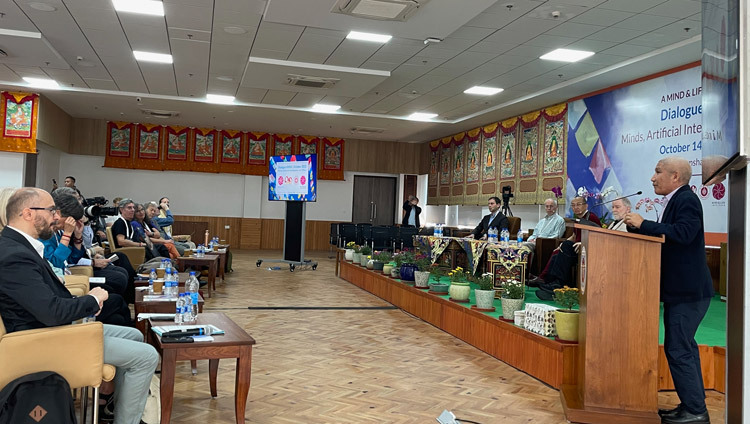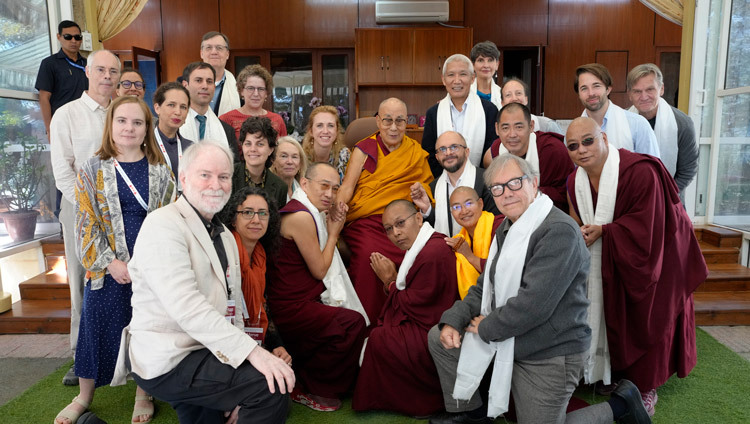Thekchen Chöling, Dharamsala, HP, India - The thirty-ninth Mind & Life Dialogue took place in Dharamsala this week. More than 120 scientists, scholars, contemplative practitioners, business leaders, policy makers and others gathered in the Dalai Lama Library and Archive building below His Holiness the Dalai Lama’s residence, to explore the nature of mind and the promise and challenge of artificial intelligence. They were joined by guests from Tibetan educational and cultural institutions.
The event was organized by the Mind & Life Institute, Mind & Life Europe and the Dalai Lama Trust. The Secretary of the Trust and Director of the Dalai Lama Library and Archive, Jamphel Lhundrup, introduced the occasion.
This dialogue, he declared, like those that have preceded it over almost forty years, took inspiration from His Holiness’s vision to create a bridge between the wisdom traditions of the East and the discoveries of the West. In 1987, the first meeting of Mind & Life laid the ground-work for what is now a global platform. The Mind & Life Institute has brought together Buddhist scholars and scientists with expertise in neuroscience, physics, cosmology, biology, and contemplative wisdom. A connection has been established between the brain, mind and ethics. The work of the Institute has inspired monks and nuns to include the study of science alongside their traditional curriculum.
Chairman of the Mind & Life Board, Thupten Jinpa, pointed out in his opening remarks that this dialogue was taking place in His Holiness the Dalai Lama’s 90th year, a period designated the Year of Compassion. He suggested that it could be regarded as an offering of practice.

He recalled that the first dialogue was organized by the brilliant Chilean scientist Francisco Varela and entrepreneur Adam Engle. They offered His Holiness a platform on which he could pursue his interest in science by bringing scientists to him. They created an opportunity for two invesigative traditions, Buddhism and science, to get to know each other.
Jinpa mentioned that His Holiness has two major objectives when he engages with scientists. One is to expand the horizons of scientific enquiry itself, to move beyond the material paradigm. He wants to bring into focus the mind side of the story, including lived contemplative experience. Meanwhile, science has developed sophisticated technology to achieve brain imaging which enabled the recognition of neuroplasticity. The Mind & Life Institute has played a huge role in opening up investigations beyond a reductionist understanding of human experience and consciousness.
His Holiness’s second objective is to see how science can serve humanity. He sees having a compassionate motivation as crucial to this.
Thupten Jinpa reported that he was fascinated by His Holiness’s underlying belief that insight could emerge through dialogue — a truly insightful discovery. Often in the West, he said, academic meetings are more like monologues. The scientist presents his or her paper, takes a couple of questions and sits down. Mind & Life imagines clear understanding emerging from collective dialogue. It creates a space to allow people to think collectively, to think aloud together. And the nature of this dialogue is multi-disciplinary.
Thupten Jinpa revealed how happy he was that the theme of this year’s dialogue was ‘Minds, Artificial Intelligence and Ethics’ because how human beings come to coexist with AI is going to be a defining question of our time. He observed that we will have to dig into the deepest, most diverse resources of human knowledge to prevent the terms of the discussion and debate being taken over by loud voices. Humanity’s future is at stake.
He added that he was looking forward to seeing how the “magic” of Mind & Life unfolds in this connection. He conceded his interest in AI, but, lacking access to research, finds himself unable to be sure about what is real and what is hype.
The dialogue unfolded in six two-hour sessions. Panels of four presenters were drawn from the following faculty: Emily M. Bender, University of Washington; Ani Choyang, Jangchub Choeling Nunnery; Molly Crockett, Princeton University; Robert Cummings, University of Mississippi; Marc-Henri Deroche, Kyoto University; Jason Gabriel, Google DeepMind; Shaun Gallagher, University of Memphis; Peter Hershock, East-West Center; Merve Hickok, Center for Al and Digital Policy; Thupten Jinpa, Mind & Life Institute Board Chair; Khangser Rinpoche, Gyuto Monastery; Sasha Luccioni, Hugging Face; Chiara Mascarello, University of Padua; Kate Nave, University of Edinburgh; Anat Perry, Hebrew University of Jerusalem; Geshé Lodoe Sangpo, Gaden Jangtsé Monastery; Murray Shanahan, Imperial College London, Google DeepMind; Luc Steels, University of Brussels; Geshé Thabkhé, Sera Jay Monastery; Marieke van Vugt, University of Groningen.
Each speaker had ten minutes to make their presentation. This was followed by discussion among the members of the panel. Then, after a short break, members of the audience were able to ask questions.
During the final session in the afternoon of Thursday 16th October, Luc Steels, a member of the Program Planning Committee as well as a presenter gave a thorough summary of the main themes of the meeting. Firstly there was discussion of the potential for AI to alleviate suffering, to promote equity and social harmony, as well as supporting flourishing on earth. Secondly, the risks AI poses to health and well-being, for work, education, politics and climate action were examined. Thirdly, the meeting examined what kind of ethical quality might and should human beings infuse into artificial forms of intelligence such that it avoids harmful effects and instead benefits the well-being of all on earth.
These major themes were divided into five sessions. The first was about mind from a philosophical point of view. The next was about disentanglement and meaningful relationships. The third session was about collective narratives and possible futures. Then there was a session about diversity and ethics and finally a session on education.
Four questions came up in all these sessions. The first was to ask what AI is doing right now and what we can do with it? The second concerned what the impact of using it will be on us and on society. These are questions about AI as it is now. But presenters were also interested in the future, and there was a general sense that the future can be created and has to be created by human beings. The meeting offered an important opportunity to set the direction for what AI can do in the future and how we get there.
So, what does AI do now? There were various examples of ChatBots, but the meeting largely focussed on those applications that are relevant to us as human beings. Many other conferences have talked about what AI can do for data science or analysis of date and so forth. The point here was to focus on topics that concern human beings.
There were a couple of warnings. The first was that we should not be too carried away by the hype that is created by the PR departments of big companies. We should remain calm and take a critical view of AI.
Shaun Gallagher made the point that could be called the ‘Turing test fallacy’, that there is a big difference between simulating something and actually being it. So, if a chatbot says “I feel compassion for you,” these are just words and we should not be tricked into believing that that system has compassion or feels compassion.
Thubten Jinpa advised that we have to be careful about how we use language. There is a slippery slope when we start to use words that make sense in a human context and apply them to other situations or entities. Molly Crocket referred to not getting caught by techno-optimism or human pessimism. We should not forget the primacy of human beings in all of this. Human being are way beyond what current machines can do and this will remain the case for the forseeable future.
Emily Bender pointed out how careful we must be about the anthropomorphizing AI, not reading too much into what we see or what we’re told.
If we ask what is the impact now? of course the impact is huge, and there’s more of that coming. Jinpa talked about creating a new reality. A new reality we become part of whether we like it or not, depends on how far we are willing to go to play in the theatre being created by AI. The point has been made that when recipients of certain texts or users of certain chatbots and so on realize that what they are dealing with is AI, their attitude changes. It’s important to be alert to this.
Presenters and members of the audience were especially concerned about the impact of AI on children and young adults. AI has appeared in the world but we don’t know what its effects on mental development will be. There has not been enough research. We are all like guinea pigs. In connection with our children and grandchildren much more care must be taken.
Sacha Luccioni drew attention to the use of resources — another major problem. While everyone was trying to save energy, a technology has been developed that completely undermines those efforts.
With regard to possible futures for AI Luc Steels remarked that one word he had heard a lot was compassion — something to strive for. Another key word was responsibility — because with power comes responsibility. It was agreed that there should be more transparency, more attention to values, and more leverage for educators. Geshé Lodoe Sangpo recommended that we use AI to connect not to avoid. AI cannot love, he said, but it can help us love better. There is a need to use AI to bring about change and inner growth not conflict. Keeping this in mind, we can co-create the future, but to do so we have to take action.

When presenters and guests of Mind & Life Institute and Mind & Life Europe attended a receiving line audience with His Holiness today he told them:
“If we can hold these kind of dialogues every now and then it will be really wonderful. From a Buddhist point of view too, engaging in such dialogues, rather than performing rituals and so on is very helpful. If conditions remain stable, Mind & Life can continue into the future.
“On my part, I studied in the philosophical tradition and practised debate when I was in Lhasa, taking both the challenging and responsive points of view. When we study, we are applying our minds. In my own case, when I was studying I too used my mind. Of course, when I studied as a child there was also an element of fear involved because I was afraid that my teacher might punish me.
“Scientists can take advantage of the logic and epistemology, the critical thinking, involved in our Buddhist traditions. They can benefit from them.
“These days I cultivate the awakening mind of bodhichitta every morning when I wake up, praying that all those who place their trust in me will be well. My life is totally dedicated to the welfare of others.
“I am a religious leader wearing monk’s robes, but when I give a talk I often invoke science. This is because the critical thinking we engage in is comparable to scientific inquiry.
“The moment we are born of our mother there is experience. We have feelings rooted in consciousness. Therefore, understanding how the mind works is important because life is underpinned by mind.”












